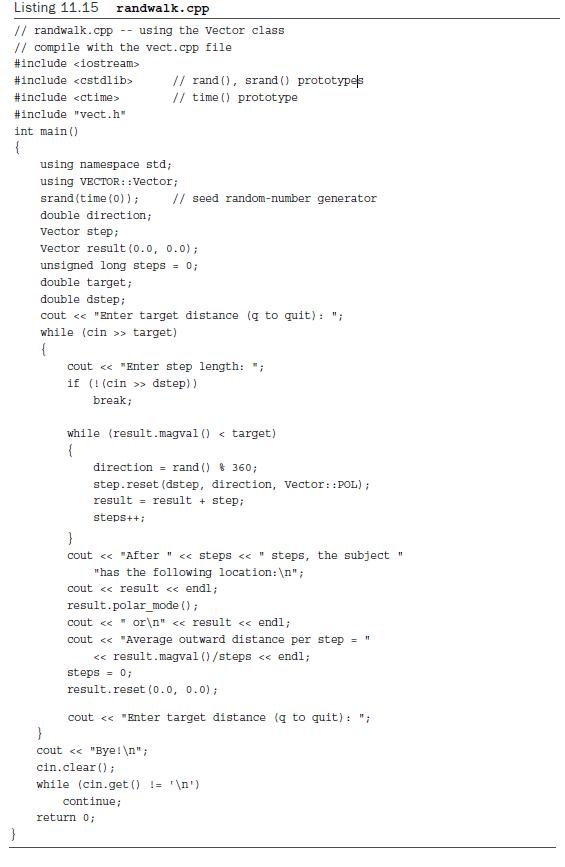Question: Modify Listing 11.15 so that it writes the successive locations of the random walker into a file. Label each position with the step number. Also
Modify Listing 11.15 so that it writes the successive locations of the random walker into a file. Label each position with the step number. Also have the program write the initial conditions (target distance and step size) and the summarized results to the file. The file contents might look like this:
Target Distance: 100, Step Size: 20
0: (x,y) = (0, 0)
1: (x,y) = (-11.4715, 16.383)
2: (x,y) = (-8.68807, -3.42232)
...
26: (x,y) = (42.2919, -78.2594)
27: (x,y) = (58.6749, -89.7309)
After 27 steps, the subject has the following location:
(x,y) = (58.6749, -89.7309)
or
(m,a) = (107.212, -56.8194)
Average outward distance per step = 3.97081

Because the program has a using declaration bringing Vector into scope, the program
can use Vector::POL instead of VECTOR::Vector::POL.
Here is a sample run of the program in Listings 11.13, 11.14, and 11.15:
Enter target distance (q to quit): 50
Enter step length: 2
After 253 steps, the subject has the following location:
(x,y) = (46.1512, 20.4902)
or
(m,a) = (50.495, 23.9402)
Average outward distance per step = 0.199587
Enter target distance (q to quit): 50
Enter step length: 2
After 951 steps, the subject has the following location:
(x,y) = (-21.9577, 45.3019)
or
(m,a) = (50.3429, 115.8593)
Average outward distance per step = 0.0529362
Enter target distance (q to quit): 50
Enter step length: 1
After 1716 steps, the subject has the following location:
(x,y) = (40.0164, 31.1244)
or
(m,a) = (50.6956, 37.8755)
Average outward distance per step = 0.0295429
Enter target distance (q to quit): q
Bye!
The random nature of the process produces considerable variation from trial to trial, even if the initial conditions are the same. On average, however, halving the step size quadruples the number of steps needed to cover a given distance. Probability theory suggests that, on average, the number of steps (N) of length s needed to reach a net distance of D is given by the following equation:
N = (D/s)2
This is just an average, but there will be considerable variations from trial to trial. For example, 1,000 trials of attempting to travel 50 feet in 2-foot steps yielded an average of 636 steps (close to the theoretical value of 625) to travel that far, but the range was from 91 to 3,951. Similarly, 1,000 trials of traveling 50 feet in 1-foot steps averaged 2,557 steps (close to the theoretical value of 2,500), with a range of 345 to 10,882. So if you find yourself walking randomly, be confident and take long steps.You still won’t have any control over the direction you wind up going, but at least you’ll get farther.
Listing 11.15 randwalk.cpp // randwalk.cpp // compile with the vect.cpp file #include #include #include #include "vect.h" int main() { } using the Vector class using namespace std; using VECTOR::Vector; srand(time (0)); double direction; Vector step; Vector result (0.0, 0.0); // rand (), srand() prototypes // time () prototype unsigned long steps = 0; double target; double dstep; // seed random-number generator cout < < "Enter target distance (q to quit): ; while (cin>> target) { cout < < "Enter step length: "; if (!(cin >>dstep)) break; while (result.magval() < target) { direction rand() & 360; step.reset (dstep, direction, Vector::POL); result result + step; steps++; } cout < < "After " < < steps < < " steps, the subject "has the following location: "; cout < < result < < endl; result.polar_mode (); cout < < or " < < result < < endl; cout < < "Average outward distance per step < < result.magval() /steps < < endl; } cout < < "Bye! "; cin.clear(); return 0; steps = 0; result.reset (0.0, 0.0); cout < < "Enter target distance (q to quit): "; while (cin.get () != ' ') continue; 11 11
Step by Step Solution
3.33 Rating (162 Votes )
There are 3 Steps involved in it
Heres a modified version of Listing 1115 that writes the successive locations of the random walker i... View full answer

Get step-by-step solutions from verified subject matter experts


